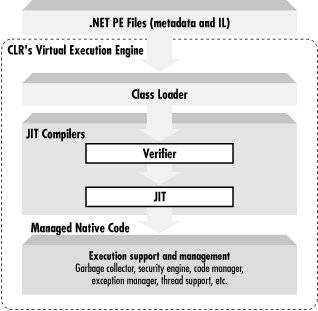CLR Execution
Now that you understand the elements of a .NET executable, let’s talk about the services that the CLR provides to support management and execution of .NET assemblies. There are many fascinating components in the CLR, but for brevity, we will limit our discussions to just the major components, as shown in Figure 2-4.

Figure 2-4. Major CLR components: the Virtual Execution Engine (VEE)
The major components of the CLR include the class loader, verifier, JIT compilers, and other execution support, such as code management, security management, garbage collection, exception management, debug management, marshaling management, thread management, and so on. As you can see from Figure 2-4, your .NET PE files layer on top of the CLR and execute within the CLR’s Virtual Execution Engine (VEE), which hosts the major components of the runtime. Your .NET PE files will have to go through the class loader, the type verifier, the JIT compilers, and other execution support components before they will execute.
Class Loader
When you run a standard Windows application, the OS loader loads it before it can execute. At the time of this writing, the default loaders in the existing Windows operating systems, such as Windows 98, Windows Me, Windows 2000, and so forth, recognize only the standard Windows PE files. As a result, Microsoft has provided an updated OS loader for each of these operating ...
Get .Net Framework Essentials now with the O’Reilly learning platform.
O’Reilly members experience books, live events, courses curated by job role, and more from O’Reilly and nearly 200 top publishers.

